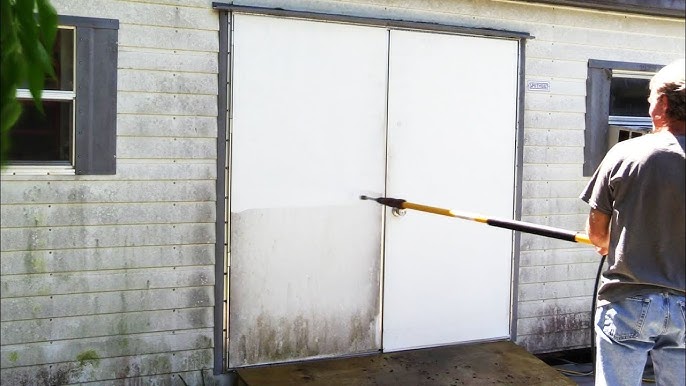
Your backyard shed or storage unit probably holds tools, lawn equipment, holiday decorations—or maybe even your secret DIY projects. But over time, these structures accumulate dirt, mildew, cobwebs, pollen, and algae, especially on the outside. That’s where power washing comes in.
However, if done carelessly, pressure washing can force water inside, warp wood, or damage roof seams—leaving you with soggy boxes or ruined equipment. 😬
In this guide, you’ll learn how to power wash sheds and storage units safely and effectively—without flooding the inside or causing costly leaks. 🧼🔐
🧱 Common Shed Materials (and What They Need)
Sheds and small outbuildings are made from various materials:
- Wood (treated or painted)
- Vinyl or resin panels
- Metal (aluminum or galvanized steel)
- Composite siding
Each surface type requires a different PSI level and cleaning approach to avoid damage.
⚠️ What Makes Sheds Leak During Power Washing?
- Spraying directly into seams, vents, or rooflines
- Using too much pressure on thin siding
- Hitting windows, door frames, or seals
- Failing to inspect for existing cracks or gaps
Water intrusion can lead to mold, rot, or even rusted tools and ruined supplies.
✅ Pre-Cleaning Checklist
- Clear the interior (or cover belongings with waterproof tarps)
- Inspect for leaks, loose panels, or roof issues
- Seal cracks with caulk or weatherproof tape if needed
- Close all vents, windows, and doors tightly
- Disconnect any electrical connections or cords
💡 Tip: Clean on a sunny, breezy day to allow full drying.
🧰 Equipment You’ll Need
- Pressure washer (1,500–2,500 PSI)
- 25° or 40° spray tip
- Mild house wash or vinyl-safe detergent
- Soft-bristle brush for spot scrubbing
- Extension wand (for taller sheds)
- Safety goggles and gloves
Avoid using a zero-degree nozzle or turbo tip—they can puncture thin siding or destroy caulking. 🚫
Browse Amazon Here For Popular Pressure Washers And Accessories
🪣 Step-by-Step: How to Power Wash a Shed or Storage Unit
1. Pre-rinse the structure
Start with a low-pressure rinse to knock off loose dirt, cobwebs, and dust.
2. Apply Detergent
Use a house wash solution appropriate for the shed’s material. Spray from the bottom up to avoid streaks.
3. Let It Dwell
Allow the detergent to sit for 5–10 minutes to break down grime, mildew, or algae.
4. Spot Scrub if Needed
Use a brush for stubborn stains or bird droppings around vents, door handles, or hinges.
5. Power Wash Gently
Use a wide-angle spray tip. Keep the wand 12–24 inches from the surface. Spray side to side, never upward or into crevices.
6. Rinse from Top to Bottom
Rinse off all detergent and residue, paying attention to avoid spraying into roof seams or vent gaps.
🧪 Cleaner Recommendations
Choose detergents that are:
- Safe for wood, vinyl, or metal siding
- Biodegradable and low-foaming
- Non-corrosive (especially for metal sheds)
Avoid bleach-heavy formulas near grass or plants surrounding the shed.
Browse Amazon Here For Wood-Safe Pressure Washing Cleaners
🧼 Post-Wash Maintenance
- Check interior for moisture or puddles
- Leave doors/windows open to air out the interior
- Reseal any weak points or exposed seams
- Touch up any chipped paint or trim
Doing so will keep the structure protected long-term and avoid any lingering mildew odor or dampness.
🚪 Special Notes by Material
🪵 Wood Sheds:
- Use lower PSI (1,200–1,500)
- Let wood dry fully before re-staining or sealing
- Avoid high-pressure near joints or baseboards
🧱 Vinyl or Resin Sheds:
- Can handle moderate PSI
- Watch for plastic warping from direct spray
- Don’t use overly hot water—it can soften plastic panels
🔩 Metal Sheds:
- Use mild soap and lower PSI to avoid denting
- Don’t spray directly at screws, rivets, or seams
- Dry thoroughly to prevent rust
🧼 How Often Should You Power Wash a Shed?
- Once per year is usually enough
- More often if exposed to lots of dust, pollen, or bird traffic
- Right before repainting or resealing exterior wood or metal
👷 When to Call a Pro
Hire a professional if:
- The shed is large or has multi-panel siding
- There’s visible mold or structural damage
- You’re worried about water intrusion or fragile seals
- You need help cleaning both interior and exterior
Pros may use soft-wash methods and containment tools to keep belongings safe during cleaning.
🧽 Final Thoughts
A clean shed not only looks better—it lasts longer and keeps your belongings safer. With the right equipment and a careful approach, power washing your shed can be quick and leak-free. Just remember to inspect first, seal what needs sealing, and avoid blasting water where it doesn’t belong. 🏚️✨
Browse Amazon Here For Popular Pressure Washers And Accessories



